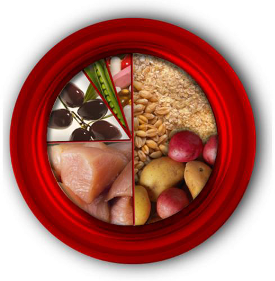|

Have you ever examined the back of your dog’s food bag? I mean really looked at it. The percentages of crude fat and other nutritional categories, the ingredients, the marketing jargon for why you should take that bag home – deciding if a food meets dog nutritional requirements gets complicated quickly.
To simplify this for dog owners, the pet health site PetMD teamed up with Hill's Science Diet, the food brand often prescribed by veterinarians, to create MyBowl. Like the new MyPlate for people, it creates a simple visual to demonstrate the nutrition your dog needs.
MyBowl divides up nutritional sources into five categories: carbohydrates, proteins, and fats and oils, vitamins, and minerals. A PDF guide gives further detailed information, like common sources for each of these categories and what to look for in the ingredients. Their recommendations in a nutshell:
• Carbohydrates for energy. Look for 2-3 sources.
• Protein should be one of the first ingredients listed.
• Fats and oils are important because some cannot be made by the body and must come from food sources.
• Vitamins typically come from fruit and vegetable sources.
• Minerals may come from fruits, vegetables, proteins, or grains.
There are two major flaws with MyBowl: It assumes a one-size-fits-all diet and it doesn’t make many recommendations on quality of nutritional sources.
MyBowl is based on a generic diet for adult dogs. It does not make any recommendations based on size or health needs. For example, it says to look for “whole grain” sources of carbohydrates and lists both wheat and corn as examples of carbohydrate sources in dog food. Many dogs have allergies to grains, hence the recent popularity of grain-free dog foods. Yet there is no mention of this on MyBowl. Another example: recommendation for omega 3 and omega 6 fatty acids, which have numerous health benefits. The trouble is, this is an area where size matters. Dosages are important. But there is no mention here of how much fatty acid a dog should get, much less variances for different sizes or health needs.
Then there’s the issue of ingredient quality. As mentioned above, MyBowl lists corn and wheat as common carb sources. While this is true, the fact is they are cheap fillers with little nutritional value for dogs. Potato, oats, and rice are better sources. They also recommend looking for a specific protein listed ahead of the word “meal” on an ingredients list, e.g. chicken meal instead of just “meal.” But meal of any kind is hardly the best protein source for your dog. Again, it’s cheap so many lower-cost foods use it, but your dog is better off getting chicken, minus the meal. MyBowl doesn’t distinguish between high-quality and low-quality nutritional sources, nor potential reactions to ingredients.
If you’re curious about dog nutritional requirements, MyBowl is a decent place to get basic information. It was recently launched, so it may expand with more detailed information as time goes on. For now, you’re better off asking your vet or a dog nutritionist for detailed recommendations on good ingredients and what your dog needs.
Was this post useful to you? Get more helpful dog care tips by signing up for the PawPosse.com newsletter. It's easy - just enter your name and email address in the green box at the top right of this page.
If you liked this, you may also like:
Best Dog Food For Itchy Skin
Choosing The Best Dry Dog Food
Photo credit: Hill's Pet Nutrition Inc.
|